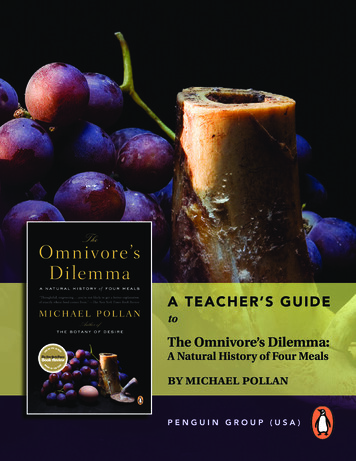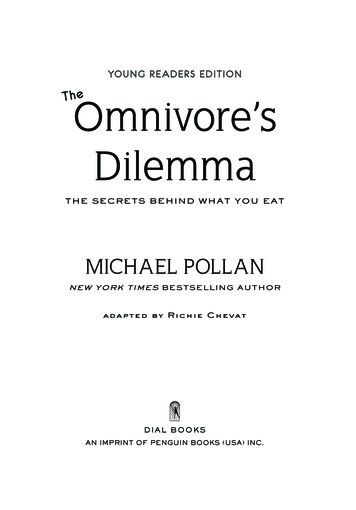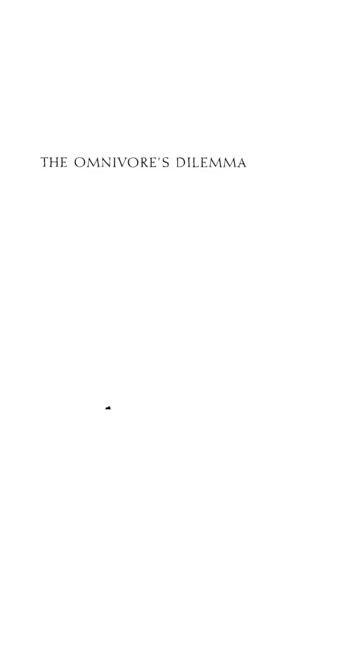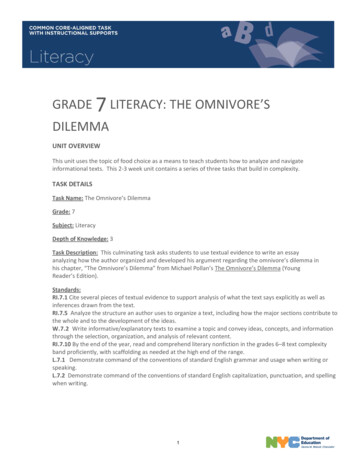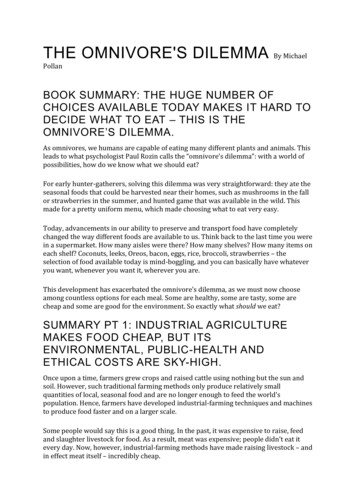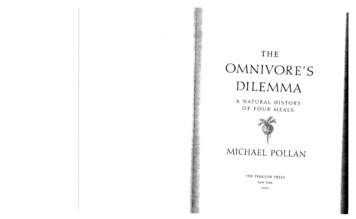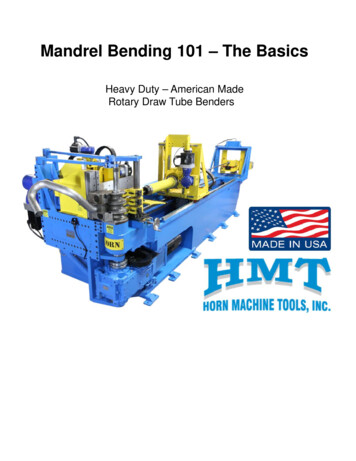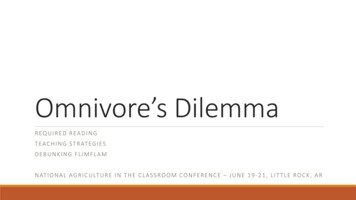
Transcription
Omnivore’s DilemmaREQUIRED READINGT E A C H I N G S T R AT E G I E SDEBUNKING FLIMFLAMN AT I O N A L A G R I C U LT U R E I N T H E C L A S S R O O M C O N F E R E N C E – J U N E 1 9 - 2 1 , L I T T L E R O C K , A R
Who has read it?I loved it!It was okay.It made me mad.Haven’t read it.
Required ReadingSchool districts using Omnivores Dilemma as required units: Idaho Core – 8th grade: nit-Plan.pdf Connecticut 7th grade: i-assessment Madison, Mississippi 8th grade: Centricity/Domain/2647/Module4Unit1Day5.docx Mason City, Iowa – 6th grade, all subjects. New York – Common Core – 8th grade le-4 7th grade: icity/Domain/106/7th Grade The Omnivores Dilemma.pdf Nationally EL Education: 2012/grade-8/module-4/unit-1/lesson-1Teaching Channel: ngePenguin: Omnivore-Teachers-Guide.pdfAchieve the Core: ni-assessmentTeacher Vision: vores-dilemma-classroom
Required ReadingCase Study of one New York school after reading and their student responses:“Do you ever stop and think, ‘I kill animals for a living’?”“The way the majority of farms grow their food is damaging the earth.”“The way we treat the animals on farms is often inhumane and should be regulated.”“CAFOs have been proven to create toxic pollutants, allow bacteria to make it’s way into ourfood, and force animals to eat food that isn’t meant for their bodies.”“Do you farmers ever feel bad about your job?”“Do you ever wish you had chosen a different job than farming?”
Current: Food ChainIn biology class, you may see a food chain that goes sun-grass-mouse-hawk. But most people inthe United States are removed from this natural food chain. Instead, our food takes a variety ofpaths from the farm to our fridge.The next time you eat a meal, think about the path it took to get to your plate. Where did all theparts come from? Write a list of the food, its components, and, if you can, trace them back totheir farm, state, or country of origin.
Teaching strategy – Setting contextReframe: For the last 10,000 years of human history humans have been removed from thenatural food chain. Agriculture allows us to cultivate and raise and produce our food. Weproduce more food which has then led to advances in society that hunter-gathers never could. 1/0/25/ e seeds of change/ px riculture/
A World Without Farmershttps://youtu.be/joUggaD6Mr0
Teaching strategy – Alternatives?Current: Corn—It’s What’s for Breakfast (and Lunch and Dinner)According to The Omnivore’s Dilemma, “There are some forty-five thousand items in the averageAmerican supermarket and more than a quarter of them now contain corn.” You may recognizecorn on the cob, or in a can, or even as a bag of chips, but corn sneaks into all kinds of food.Manufacturers also turn corn into hydrogenated oil, corn syrup, sweeteners for your soda,cornstarch, ethanol, plastic, animal feed . . . and the list goes on. Study the ingredients on a cereal box. What are they? Where do they come from? Use theInternet to help you.Reframe: Q. Why do we use corn? A. It is cheap and easy to grow. It has a lot of different uses(starch, sugar) What forms of the corn are we using?If we didn’t use corn, what else would we use?If not, corn syrup, then sugar from sugar beets or sugar cane.If not corn starch, then starch from wheat or potatoes.
Teaching strategy - Investigation
Current: Corn—It’s What’s for Breakfast (and Lunch and Dinner)According to The Omnivore’s Dilemma, “There are some forty-five thousand items in the averageAmerican supermarket . How did all this corn get into our food? Government subsidies, shifting populations, andscientific advances have made corn our most plentiful crop and common ingredient. Create atimeline that charts the rise of corn in the U.S. Include political and technological milestones.
How should U.S. farmersrespond?U.S. farmers see an opportunityto sell their products toEuropean consumers and soramp up production.
U.S. farmers arecoming off of highproduction yearsfollowing WWI. Whathappens next?Severe weather eventscause failed crops for aseries of 10 yearscausing major foodshortages throughoutthe U.S.
Teaching strategy – Digging deeperReframe: Why has the government provided subsidies for farmers to plant corn? Subsidies helpreduce the erratic swings in markets that can be caused by things like increased production tofeed a war ravaged Europe after WWI or a dramatic decrease of production from the GreatDepression and Dust Bowl.What are examples of subsidies?1. When too much production, government pays farmer to leave land unplanted. Reduces thesupply, keeps prices stable.2. Other subsidies were paid to farmers to mitigate boom/bust cycles associate with weatherpatterns to keep a stable food supply.3. Subsidies also create minimum prices for their crops as a type of insurance. Subsidies aren’tjust corn. Most crops are subsidized, but corn, soybeans, wheat, cotton and rice get the bulk /us-farm-subsidies-3325162
Corn—It’s What’s for Breakfast (and Lunch and Dinner)Corn—It’s What’s for Breakfast (and Lunch and Dinner)Current: “Chapter 3: Using information provided by Pollan, create a flowchart, showing the keyevents government regulators played a role in helping corn, starting from 1947.”Reframe: Only use information from Pollan? How about critical thinking and using multiplesources.
Current: “Chapter 5: Pollan purchases Steer number 534and follows him as travels through the meat-makingbranch of the industrial food chain. Follow Pollanjourney and create a timeline, showcasing the eventsPollan witnessed in Steer number 534’s life.”
Teaching strategy – Both sides of the storyCurrent: “Chapter 5: Pollan purchases Steer number 534and follows him as travels through the meat-makingbranch of the industrial food chain. Follow Pollanjourney and create a timeline, showcasing the eventsPollan witnessed in Steer number 534’s html
Teaching strategy – Real talkReframe: Yes, look at the journey, life cycle, of the animal. But then also look at what the animalis used for after slaughter.Pig 05049: Pictures document the array of various products that different parts of ananonymous pig called 05049 could support. This is what the pig means to mankindYes, understand the process. People are too desensitized. Humans are omnivores. We eatanimals. To eat animals, they must be killed.Don’t personify the steer. Livestock have a purpose.
Current: “Chapter 6: Document what you eat over a 24-hour period. Using Pollan’s diagramfeatured on pages 82-83, highlight the food products made from corn that you consumed. Whatpercentage of the total food consumed is made from corn? What items on the list were yousurprised to learn were made from corn? Be prepared to present your findings to the rest of theclass.”
Teaching strategy – Be specificReframe: Be specific. What type of corn ingredient (starch, syrup, other)? What is the purposeof the corn in the food? Starch as a stabilizer? Syrup as a sweetener?How much of the final product was corn? Was it the whole product or just one ingredient?If the corn ingredient wasn’t present, how would the quality, taste, texture, or health of the foodchange?If the corn ingredient wasn’t present, would food manufacturers replace it with something elsethat is similar?What are the goals of food manufacturers? (safe, shelf stable, appealing to consumers– tastyand looks good) Food manufacturers don’t always prioritize health as that is a consumerresponsibility to eat minimal sweets and a balanced diet.Discuss the role and the responsibility of the consumer to eat healthy foods versus the role offood manufacturers to provide healthy food options?
Organic? Oh Really?Many large corporations have organic brands. Some organic produce is shipped thousands ofmiles before it reaches your supermarket. Choose an “organic” processed food from the grocery store.Use the USDA chart to find out how organic the item really is.
Teaching strategy – Build on prior knowledgeCurrent: “Chapter 10: Pollan lists key dates and people who played a role in the birth of organicfood. Using information from the text, create a timeline of these events. Additionally Pollanmentions cultural movements and other key events that were happening around the countryduring the 1960s and 1970s, which also contributed to people’s awareness of eating organic.Explore these events further and add visual images of your research, including captions, to yourtimeline.”Reframe: Make sure students understand what organic means. Chemicals can be used. Noteconomically sound. Conflated with the GMO issues.
Teaching strategiesCurrent: “Chapter 12: Examine the chart on page 173, comparing Naylor farm to Polyface farm.Replicate the chart and also include a definition and visual image for each term listed undereach farm.”Reframe: Compare the two operations to a modern, large scale farm. There will likely be a lot ofsimilarities. What are the positives and negatives of each?
FlimflamDebunkedClaim 1: The modern American diet consists mainly of processed corn. "'When you look at the isotope ratios,' Todd Dawson, a Berkeley biologist who's done this sort of research, told me, 'we NorthAmericans look like corn chips with legs.'" (23) A McDonald's meal by part (using a mass spectrometer): soda-100% corn by-products, milk shake- 78% corn, salad dressing- 65%,chicken nuggets- 56%, cheeseburger- 52%, french fries- 23% (117) No scientific method, qualitative data vs. quantitative data, interpretation of data
FlimflamDebunkedClaim 2: American agriculture was revolutionized in the 1970s by Earl Butz. 1920 invention of synthetic nitrogen fertilizer exponentially increased crop production. Supported exponential population growth. During the Great Depression, the establishment of the Ever-Normal Granary, reduced surplus of corn, now a staple in American diets, as wellas put in place the systems to reduce shortages through use of loans. In 1972, in an effort to get Nixon re-elected, Earl Butz orchestrated a deal with struggling Russia to sell them 30 million tons of Americangrain. The demand for corn skyrocketed and prices boomed. This was great for farmers and the economy in the short-run and Nixon got reelected. However, inflation soared making it difficult for consumers to purchase corn products. Nixon and Butz encouraged more productionof corn to increase the supply. The 1973 Farm Bill replaced the Ever Normal Granary and loans with subsidies and direct payments to farmers instead. This doesn't keepcorn out of the market when there is a surplus. It does the opposite, it encourages more corn production during a surplus. Earl Butz's revolutionary changes in agriculture policy have resulted in a ".plague of cheap corn. impoverishing farmers., degrading theland, polluting the water, and bleeding the federal treasury, which spends up to 5 billion a year subsidizing cheap corn." (54) ".the smart thing to do with all that surplus grain is to process it. there are hundreds of things a processor can do with corn: They can useit to make everything from chicken nuggets to Big Macs to emulsifiers and nutraceuticals. Yet since the human desire for sweetnesssurpasses even our desire for intoxication, the cleverest thing to do with a bushel of corn is to refine it into thirty-three pounds of highfructose corn syrup." (103) Requires assuming a lot of premises are true. Pollan's premises are assumed ideas taken from his list of sources including books of economists, scientistsand historians in the back. Is his sole interview really representative of the average farmer?
FlimflamDebunkedClaim 3: Grass-feeding animals is “better.” Compares Polyface Farm to the feedlot he visited (open air vs. Hazmat suits) Costs to the environment are lower (use of fertilizer, plows, driving to market, energy efficiency of grass vs corn, etc.) Increased levels of beta-carotene, vitamin E, folic acid, and Omega-3 according to the International Society for the Study of FattyAcids ad Lipids. Again, accepting other scientific evidence as fact. Only cites sources occasionally. Word connotation: "independence," "astounding," and "real.“ Case-by-case observations.
FlimflamDebunkedClaim 4: Government subsidies force farmers to grow corn. Why do taxpayers subsidize rich farmers?Mapping the U.S. Farm Subsidy 1M ClubAgricultural SubsidiesWhat You Should Know about Who Receives Farm SubsidiesSupreme Court Justice Owen Roberts voted with most of the rest of the Court to strike down the AAA as unconstitutional. Indoing so, he posed the following analogy: “Assume that too many shoes are being manufactured throughout the nation; thatthe market is saturated, the price depressed, the factories running half-time, the employees suffering. Upon the principle ofthe statute in question Congress might authorize the Secretary of Commerce to enter into contracts with shoe manufacturersproviding that each shall reduce his output and that the United States will pay him a fixed sum proportioned to suchreduction, the money to make the payments to be raised by a tax on all retail shoe dealers or their customers.”Yes, we live in a more global market and subsidy policies could be reformed.Farmers make decisions on what to plant based on a number of different factors – climate, soil, market saleprices, market input prices, machinery available, end market logistics, etc. Subsidies are only one factor forconsideration.Agricultural commodities are still at risk of unforeseen weather events or other world wide catastrophes. Humansstill need a stable food supply.The difference between food and shoes is that we can live without shoes.
FlimflamDebunkedClaim 5: Americans are becoming obese because corn is “hidden” in so many food products. The American diet is one of the most complex subjects to understand. Here are some of the issues that make it about more than just corn: GeneticsJunk FoodFood AdditionAggressive MarketingInsulinFood AvailabilityMisinformationSugarBehaviorCommunity EnvironmentPortion sizeDiet vs. NutritionInactivity ity/ https://www.cdc.gov/obesity/adult/causes.html
FlimflamDebunkedClaim I agree with:We have a national eating disorder: the Omnivore's Dilemma- too many food options, littleknowledge to choose correctly. Countries without obesity problems have had a stable cultural cuisine for thousands of years. Example: France.Eat unhealthy foods but adhere to cultural standards like small portions, no seconds, no snacks, eating as afamily. Evolved to have a healthy lifestyle. Being that the combinations of these unhealthy and healthy habits vary by culture and each have a delicatebalance, the American "melting pot" of cultures really works against us to create a cultural knowledge ofhealthy eating habits.Counter claim: We are genetically predisposed to eat healthy with: neophilia (openness to new tastes)Neophobia (a sensible fear of ingesting something new)tastedisgust
Recommended Reading– History of Food
Recommended Reading– Eating Animals
Recommended Reading– Eating Animals, Beef
Recommended Reading– Corn
Recommended Reading– Biotech, Future, Perspective
omnivore’s dilemma required reading teaching strategies. debunking flimflam. national agriculture
